How to Find Product-Market Fit: A Proven Guide for Startup Founders
Why some startups grow effortlessly, and how to tune your product to your market’s frequency to unlock Product-Market Fit.
This is a guest post by Eduardo Ortiz de Lanzagorta: 3x founder, YC W22 alum, and co-founder of Fuel, acquired by the unicorn Factorial. He’s now building Codapt.ai, the first AI that writes full-stack software (not just mockups), and sharing founder insights in his newsletter The Founder's Notebook.
What separates the startups that grow like wildfire from the ones that stall, pivot, and slowly fade out?
It’s rarely effort. It’s not always talent. And despite what Twitter might tell you, it’s not some magical go-to-market playbook.
Early in his career, Eduardo noticed something strange: two founders with similar skills, ambition, and ideas could end up with completely different outcomes. Some caught lightning in a bottle. Others did everything right—and got nowhere.
At first, people attributed it to "execution." But the real reason was more fundamental. Some founders were simply aligned with something bigger: a deep market need. Others were swimming upstream, trying to brute-force growth without ever hitting resonance.
The turning point came when Eduardo, who studied engineering, learned about the collapse of the Tacoma Narrows Bridge, where modest wind caused total failure, simply by matching the bridge’s natural frequency. That single insight stuck: great things happen when something is tuned perfectly to the system it lives in.
“What if startups work the same way?”
“What if Product-Market Fit is really just resonance—when your product hits the market in exactly the right way, and everything amplifies?”
From the Wright brothers to Brex, Eduardo saw this same principle play out again and again. The most successful founders weren’t just building hard. They were building in harmony with a force already in motion.
The best founders don’t push the river. They widen the bank.
In this piece, Eduardo lays out the founder journey he wishes he’d understood sooner: why Product-Market Fit is the only thing that matters at the start, how to actually find it, and what to do next.
He distils insights from Andy Rachleff, Paul Graham, and Y Combinator, then mixes in lessons from physics, cooking, and his own 10+ year journey building and investing in startups.
Table of Contents
Why Product-Market Fit Is the #1 Priority for Early-Stage Startups
Why doesn't traction matter until you're solving the right problem for the right people?How to Choose the Right Problem and Market for Your Startup
A founder’s framework for identifying ideas with real potential and hidden demand.What ‘Just Launch’ Really Means—and Why It’s Key to Finding PMF
Why speed beats polish, and how launching fast helps you get real feedback sooner.How to Sense Product-Market Fit Using Founder Intuition and User Signals
What it feels like when it’s working, and how to recognise when it’s not.How to Measure Product-Market Fit with Retention, Interviews, and Surveys
The exact signals and metrics that top founders use to validate PMF.The Proven Process for Finding Product-Market Fit from Scratch
A step-by-step guide to test, iterate, and land on a product the market pulls toward.When to Scale Your Startup: Only After Product-Market Fit
Why premature scaling kills startups, and how to know when you’re truly ready.The Most Important Lesson Every Founder Learns About PMF
What hundreds of founders wish they knew earlier, and how to apply it now.
Whether you’re pre-launch or post-Series A, this is one of the clearest guides to Product-Market Fit I’ve read. Let’s get into it.
1. Why Product-Market Fit Is the #1 Priority for Early-Stage Startups
“The number one problem I’ve seen for startups is they don’t actually have product/market fit when they think they do.”— Alex Schultz
"Most businesses that fail do so because they don’t give customers what they want. Restaurants are a great example: about a quarter close their doors in the first year. But have you ever heard of a restaurant with outstanding food that went under? No. Even if it’s pricey, noisy, dingy, or tucked away, people will line up for great food. Sure, mediocre restaurants can draw a crowd with gimmicks—but that’s a risky, short-lived strategy. It’s far simpler to just serve amazing food.”— Paul Graham
You’ll hear endless explanations for startup failures (poor leadership, bad timing, lack of capital…) but can you name a company with a great product that still went under? Almost never. When a startup dies, it’s almost always because customers simply didn’t want what they were selling.
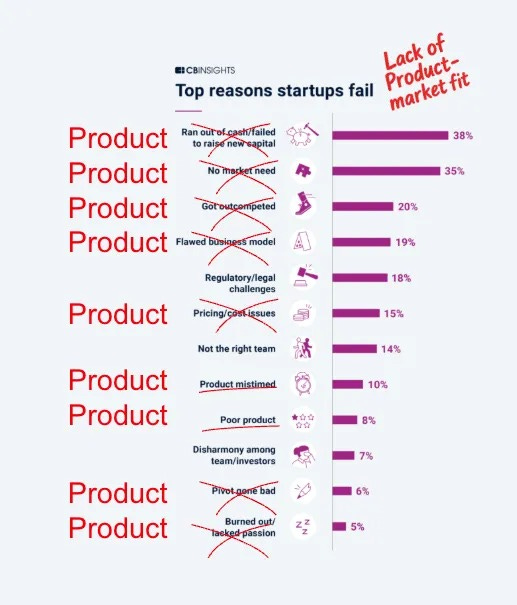
2. How to Choose the Right Problem and Market for Your Startup
“If you address a market that really wants your product — if the dogs are eating the dog food — then you can screw up almost everything in the company and you will succeed. Conversely, if you’re really good at execution but the dogs don’t want to eat the dog food, you have no chance of winning.
—Andy Rachleff
Most people think there’s no recipe for this. And while it's true that no one really knows what will work (not even top VCs), there is a framework to “safely” discard many ideas, because you do know they won’t work with a high level of certainty. This lets you focus only on the good bets, those with a real chance of winning. How? It all comes down to one insight: the market is almost perfect, it fills opportunity gaps very fast. That’s why the best startup ideas usually hide in a few places—where opportunity gaps have just opened, or where less competition has made the market less perfect. Here are five of them:
1. New Technology Unlocks
A breakthrough in technology suddenly makes it possible to solve an old problem in a radically better way.
📌 Example: Brex
Corporate cards always existed—but with Banking APIs Brex reimagined the underwriting experience for startups from scratch. Suddenly, you could get much higher credit limits.
Ask yourself:
What’s old problem can now be solved in a radically better way?
But also consider the reverse: Let’s say it’s 2025 and you’re building “a tool to organize weekend plans.” Hold up. Has the tech to build this existed for 20+ years? Yes. So why hasn’t someone already nailed it? Most likely: There are not enough people who share that problem, or it’s a human problem, not a tech problem, or it's just a very bad business.
2. Regulatory Shifts
New laws or regulations create temporary windows of opportunity or gaps in the market that can be filled.
📌 Example: Factorial
In Spain, a new regulation made it mandatory for businesses to track employee working hours. After that, everyone needed a system.That allowed Factorial (a Spanish Unicorn) to start growing. When the rules change, new solutions like Factorial are needed.
Ask:
What new problems have regulations created, problems that didn’t exist before and now need solving?
3. “Too Complicated” Markets
If a market looks messy, bureaucratic, or technical, most founders avoid it. That’s a signal—not a warning.
📌 Example: SpaceX
Rockets hadn't meaningfully improved in decades. Everyone assumed only governments could build them. They were wrong.
Ask:
What feels too messy or specialized for most startups to touch?
4. “Unsexy” Markets
Boring industries are full of real problems—and few competitors.
📌 Example: Flexport (freight) or Ramp (expense software)
These aren’t glamorous, but they’re massive and neglected.
Ask:
What problems exist in industries no one talks about at startup events?
4. Not obvious
If everyone around you agrees it’s a great opportunity, it’s probably too late — unless you’ve made a tech breakthrough no one else has seen yet. If you are using a technology anyone can use, why is the opportunity still there?
3. What ‘Just Launch’ Really Means—and Why It’s Key to Finding PMF
Y Combinator nailed it with one image. You don’t need a pitch deck, perfect branding, or a polished website. You don’t need to wait for funding. You don’t even need all the features. You just need to launch.
Why? Because nothing teaches you faster than shipping something real and putting it in front of users. That’s how you learn what matters—and what doesn’t.
Start with Something Minimal
If you’re stranded on a desert island, surrounded by nothing but sand and hunger, you don’t need a fancy carbon-line fishing rod. A simple rock to throw at fish and crabs will do. One single feature that solves a hair-on-fire problem.
If the problem you're solving needs 15 features, you’re probably solving the wrong problem. Lack of features is rarely the real issue.
As Paul Graham says, get a version 1 out as soon as you can. The only way to make something customers want is to get a prototype in front of them and refine it based on their reactions
Many founders highlight how valuable it is to start with the simplest possible version of their product. The idea of launching quickly and improving through feedback is well-known, especially at places like YC. Still, it’s something that trips up a lot of people.
So why does the first version often take longer than it should? Often, it comes down to wanting things to be more polished. There's a natural hesitation to share something that feels incomplete, and a fear of how it might be received. Get over it.
In the age of AI, anyone can build software. But here’s the real question: are you building real software—or just a demo? Try tools like Bolt or Lovable. What you get might look real at first… but it’s just the surface. No backend. No real database. And the worst part? You don’t fully own it. You’re tied to third-party platforms like Supabase just to keep it running.
That’s not how great products are built. Airbnb, Facebook, Booking.com—these all started with full-stack foundations they controlled completely.
That’s why we built Codapt.ai. We are in private beta, quietly, since 2023. The first AI that generates real, production-ready software out of the box: frontend, backend, database—fully yours.
Codapt allows you to launch in minutes, not months. Launch, learn, and iterate.
In this video I built and launched Hubspot Clone and Cal Ai Clone in 1 hour starting from scratch using Codapt.ai:
And if you’re still using those tools? Here are 7 reasons they’ll hold you back from building anything real → read post.
4. How to Sense Product-Market Fit Using Founder Intuition and User Signals
You can feel Product-Market Fit before you can measure it. That’s the paradox.
As Marc Andreessen puts it:
“You can always feel when product/market fit isn’t happening... and you can always feel when it is.”
When PMF is missing, everything feels like a grind. Customers don’t quite get the value, word of mouth doesn’t spread, usage grows slowly (if at all), sales cycles drag on, and no one seems excited. Press coverage is lukewarm. Deals stall. Nothing clicks.
But when PMF clicks, everything changes.
Users adopt your product as fast as you can ship it. Or your servers buckle under usage because you can’t scale fast enough. Revenue starts flowing in without pushing. You’re scrambling to hire support and sales teams. Reporters start calling you. Customers tell their friends. You start getting emails from investors, awards from schools, and recognition from places you’ve never pitched.
You’re no longer selling. You’re getting pulled forward.
That’s what PMF feels like: a shift from pushing to being pulled by the market, by customers, by momentum.
If you're unsure whether you've found it, you probably haven’t. But once you do, you’ll know.
5. How to Measure Product-Market Fit with Retention, Interviews, and Surveys
How to measure PMF objectively: Listening To Customers
Don't just ask, “Would you use this?” or “Do you like the idea?”
Those are polite-question traps. People will nod, smile, and never use your product. Instead, go deeper:
“When was the last time you experienced this problem?”
“What did you do to solve it?”
“How much did that cost you (in time or money)?”
“Do you know others struggling with the same thing?”
Avoid binary questions (“Would you use this?” “Is this a good idea?”). Avoid fishing for compliments. You’re not looking for validation. You’re looking for evidence of pain. Because if the pain is real, people will tell you stories. If it’s not, they’ll just say “cool idea.” And that’s your red flag.
How to measure PMF objectively: Sean Ellis User Survey
Once you’ve launched and have early users, run the Sean Ellis survey to gauge how much they actually care.
It’s simple. For example:
“How would you feel if you could no longer use this product?”
Very disappointed
Somewhat disappointed
Not disappointed (it really isn’t that useful)
I no longer use the product
If 40% or more say “Very disappointed,” you’re on the path to Product-Market Fit. Sean Ellis’ Demo and survey -> Link
How to measure PMF objectively: Retention
The most important thing is retention. If users come back, it means they care. If they don’t, nothing else matters. Other interesting KPIs to pay attention to: Quick Ratio.
Retention tells you if your product is truly solving a problem. To measure it:
Track user cohorts — e.g. users who signed up in Month 1, Month 2, etc.
Check how many are still active after each month.
Visualize it: use a retention curve. ⚠️ One key insight: you are good if it goes flat, instead of dropping endlessly
Flattens to what %? Find below great benchmarks for every type of business.
6. The Proven Process for Finding Product-Market Fit from Scratch
As Reid Hoffman notes, “The process of finding PMF fit is a science rather than an art. PMF emerges from experiments conducted by entrepreneurs. Through a series of build-measure-learn iterations, PMF is discovered and developed during a process rather than a single Eureka moment. A-ha moments of inspiration do happen, but PMF is not created that way.”
“You often stumble into your product/market fit. Serendipity plays a role in finding product/market fit but the process to get to serendipity is incredibly consistent. What we do is teach that incredibly consistent process.” Andy Rachleff
Start with a hypothesis, test it, prove it, move on or further iterate on the hypothesis.
Fast iteration is the key to success: be a virus.
Can we actually learn something from how a virus behaves? Surprisingly, yes. A brainless, fast-mutating virus almost always spreads before the smartest scientists can respond. The virus is not brilliant—in fact, it’s brainless. It just needs to mutate fast.
“A startup idea is a hypothesis rather than a blueprint. Mere determination, without flexibility, is a greedy algorithm that may get you nothing more than a mediocre local maximum: When someone is determined, there's still a danger that they'll follow a long, hard path that ultimately leads nowhere. You want to push forward, but at the same time twist and turn to find the most promising path. One founder put it very succinctly” Paul Graham
Even in the rare cases where a clever hack makes your fortune, you probably won't know till later. So the best strategy is to try lots of different things.
“One reason this advice is so hard to follow is that people don't realize how hard it is to judge startup ideas, particularly their own. Experienced founders learn to keep an open mind: Now I don't laugh at ideas anymore, because I realized how terrible I was at knowing if they were good or not.” Paul Graham
7. When to Scale Your Startup: Only After Product-Market Fit
“Startups need 2-3 times longer to validate their market than most founders expect. This underestimation creates the pressure to scale prematurely… In our dataset we found that 70% of startups scaled prematurely along some dimension. While this number seemed high, this may go a long way towards explaining the 90% failure rate of startups.”
One of the most common ways that startups die is “premature scaling,” a term first used by Steve Blank. A business is “scaling prematurely” if it is spending significant amounts of money on growth before it has discovered and developed PMF.
Andreessen argues that the life of any startup can be divided into two parts: before product/market fit (what he calls BPMF) and after product/market fit (APMF):
“When you are BPMF, focus obsessively on getting to product/market fit. Do whatever is required to get to product/market fit. Including changing out people, rewriting your product, moving into a different market, telling customers no when you don’t want to, telling customers yes when you don’t want to, raising that fourth round of highly dilutive venture capital — whatever is required. When you get right down to it, you can ignore almost everything else. I’m not suggesting that you do ignore everything else — just that judging from what I’ve seen in successful startups, you can.”
“In general, hiring before you get product/market fit slows you down, and hiring after you get product market fit speeds you up. Until you get product/market fit, you want to a) live as long as possible and b) iterate as quickly as possible.” Sam Altman
Your most important goal pre-PMF: “100 users that love you”
The key? Talking to users. The only kind of software you can build without studying users is the sort for which you are the typical user.
Try to fulfil product demand by talking to users instead of “sitting around” trying to dream up a new feature to create demand.
As PG says, once you start talking to users, I guarantee you'll be surprised by what they tell you. When you let customers tell you what they're after, they will often reveal amazing details about what they find valuable as well what they're willing to pay for.
8. The Most Important Lesson Every Founder Learns About PMF
Work on problems that genuinely interest you, the ones you truly care about. Life’s too short to do otherwise. And if you can help some people along the way, even better.
Skill matters. So does relentless effort. But luck, finding the right product at the right time, is a major piece of the puzzle. So, don’t compare yourself. The only thing you can do about it is to try many times, learn fast, and keep moving.
If water stops flowing, it becomes stagnant. The same happens with the brain and the ideas. Keep it moving. Stay curious and active.
When something’s not working, let go with clarity, not regret. You didn’t waste time. You didn’t fail. You ran the experiment, knowing most startups don’t make it. What you gained: sharper instincts, stronger resilience, and peace of mind. Because you tried. And most people don’t.
“The spirit of evil is the negation of the life force by fear. Only boldness can deliver us from fear. If the risk is not taken, the meaning of life is violated.” - C.G. Jung
Don’t put too much pressure in you. You are not your product. You are not your company. You are a person, your values, your family, your friends...
If you fail while staying true to your calling, you will be able to live with it.
Lastly, and most importantly, as my good friend Antonio E. de los M. says,
“Your company, your titles, your victories, your fortune, your mistakes…will all be forgotten. What remains is the love you give and the lives you help rise.”
I hope you enjoyed reading this as much as I enjoyed writing it ☺️
RESOURCES 🛠️
✅ How VCs Value Startups: The VC Method + Excel Template
✅ 2,500+ Angel Investors Backing AI & SaaS Startups
✅ Cap Table Mastery: How to Manage Startup Equity from Seed to Series C
✅ 300+ VCs That Accept Cold Pitches — No Warm Intro Needed
✅ 50 Game-Changing AI Agent Startup Ideas for 2025
✅ 144 Family Offices That Cut Pre-Seed Checks
✅ 70+ Startup Pitch Decks That Raised Over $1B in 2024
✅ 89 Best Startup Essays by Top VCs and Founders (Paul Graham, Naval, Altman…)
✅ The Ultimate Startup Data Room Template (VC-Ready & Founder-Proven)
✅ The 100+ Pitch Decks That Raised Over $2B
✅ Ultimate Investor List of Lists (+5k VCs)
✅ 40 Pitch Decks That Raised Over $460M
✅ The Startup Founder’s Guide to Financial Modeling (7 free templates included)
✅ SAFE Note Dilution: How to Calculate & Protect Your Equity (+ Cap Table Template)
✅ 400+ Seed VCs Backing Startups in the US & Europe
✅ The Best 23 Accelerators Worldwide for Rapid Growth (and How to Get Into Them)
✅ The Ultimate Startup & Venture Capital Notion Guide: Knowledge Base & Resources
✅ AI Co-Pilots Every Startup & VC Needs in Their Toolbox
Sources:


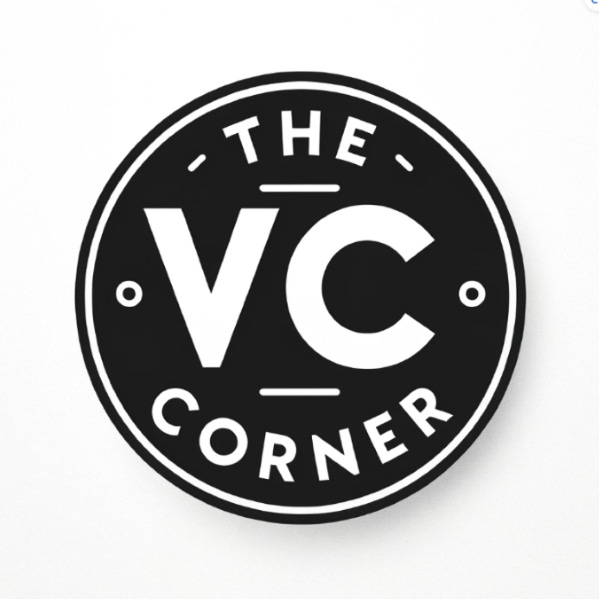
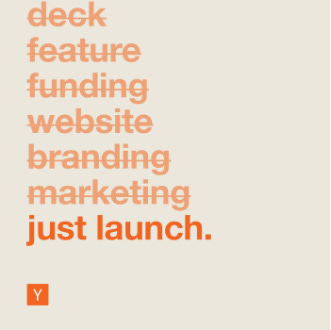

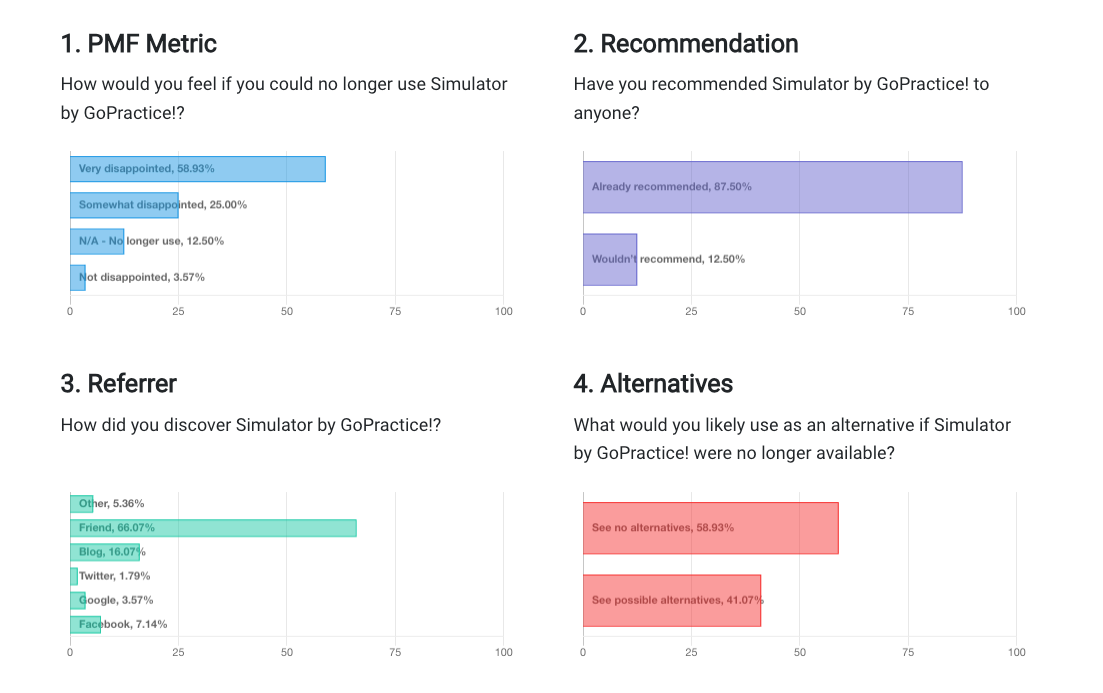

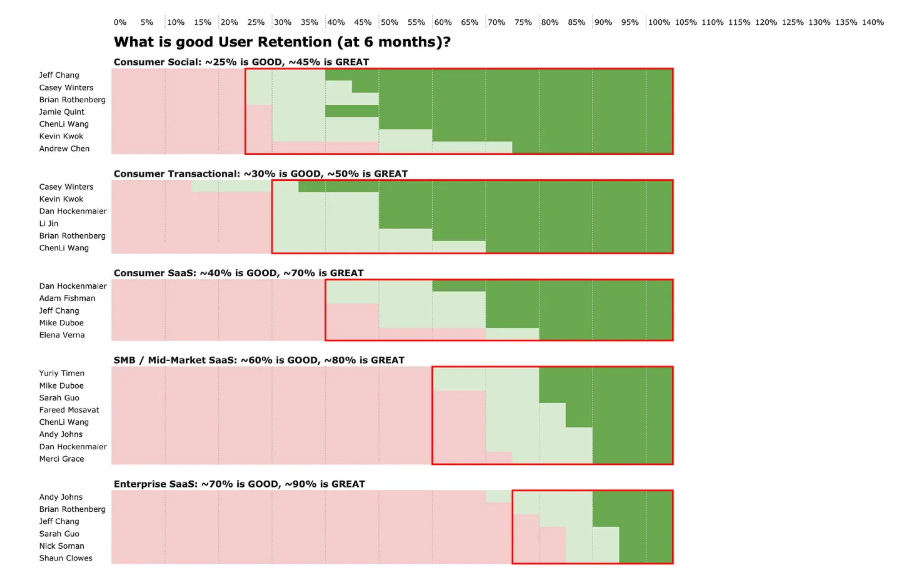


great article. I specially liked the lesson we can learn from viruses. mutate fast! thanks for sharing